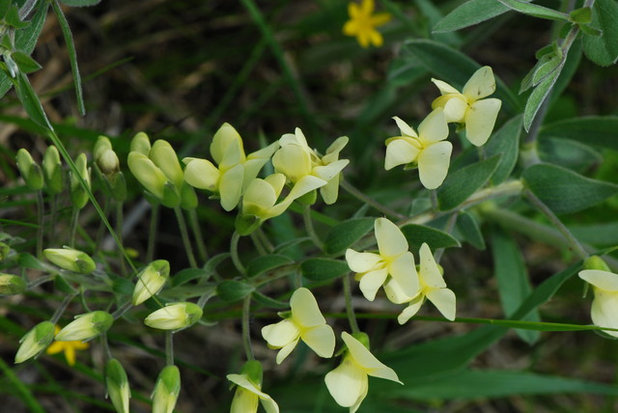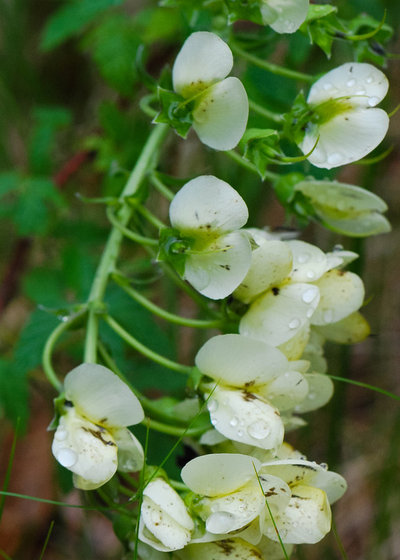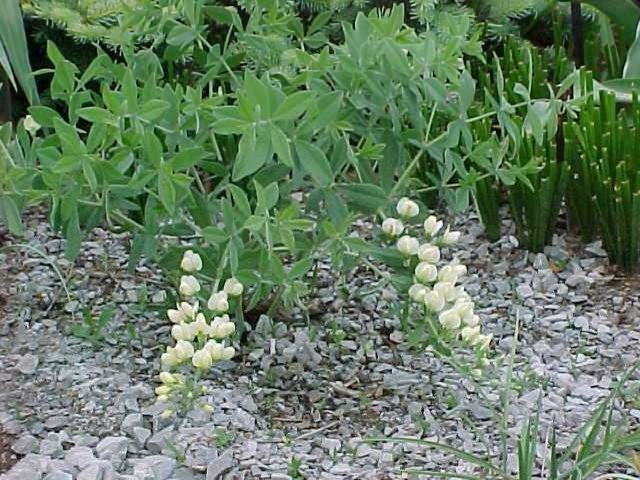Each year brings many new cultivars of the showy blue wild indigo (
Baptisia australis) and its stout cousin dwarf blue indigo (
B. australis var.
minor), with new flower colors wildlife may or may not recognize or be able to use. Never fear, we have many common native wild indigo species to choose from for various site conditions and with neat shapes or habits. Longbract wild indigo (
B. bracteata) is one of my favorites because it arches over low native grasses and will live a long, drought-tolerant life in most any sunny or part-shade landscape — even sandy and rocky. It’s also a host to several butterfly species.
 Botanical name: Baptisia bracteataCommon names:
Botanical name: Baptisia bracteataCommon names: Longbract wild indigo, cream false indigo, cream wild indigo, plains wild indigo, large-bracted wild indigo
Origin: Native from Minnesota and Nebraska south to Texas, east from Illinois to Missouri and Louisiana. Smaller populations from Michigan to Kentucky to Mississippi east into the Carolinas
Where it will grow: Hardy to minus 30 degrees Fahrenheit, or minus 34.4 degrees Celsius (USDA zones 4 to 9; find your zone)
Typical plant communities: Open meadows, prairies, rocky open woodlands and sandy areas
Water requirement: No supplemental water needed once established; prefers dry to medium soil
Light requirement: Full sun to part shade
Mature size: 2 feet tall and wide
Benefits and tolerances: Attracts early-season pollinators
Seasonal interest: Cream-colored flowers in mid-to-late spring
When to plant: Plant potted or bare-root plants from summer to fall; sow seeds in late fall through midwinter.
Photo by Joshua Mayer
 Distinguishing traits.
Distinguishing traits. Blooming in mid-to-late spring, the flowers of longbract wild indigo are primarily pollinated by larger queen bumblebees that are establishing their new nest sites. These bees have to muscle their way to the pollen by opening layers of petals, a task most other insects can’t manage — although you will see the occasional moth or butterfly stopping by. Several skipper and sulfur butterfly species use this and other
Baptisia species as a host plant, so look out for eggs and caterpillars.
The arching, almost weeping or sprawling form makes this native perennial ideal as a ground cover component or interesting specimen. Dark black pods with rattling seeds form in fall and last well into winter.
Photo by Joshua Mayer

Missouri Botanical Garden
How to use it. Longbract wild indigo’s arching, sprawling habit performs best in open areas, with other plants of similar or smaller stature, and does not like competition from nearby taller plants. Try using it among native short bunchgrasses like prairie dropseed (
Sporobolus heterolepis) or sideoats grama(
Bouteloua curtipendula), native sedges like Bicknell’s sedge (
Carex bicknellii) or shortbeak sedge (
C. brevior), and perennial flowers like purple prairie clover(
Dalea purpurea) or white prairie clover (
D. candida), black-eyed Susan (
Rudbeckia hirta) and purple poppymallow (
Callirhoe involucrata).
Planting notes. Plant longbract wild indigo in dry soil, from a clay loam to even a mostly sandy loam or mostly sandy soil. A rocky location will also work. Like other
Baptisia species, longbract wild indigo spends the first few years sending down a deep taproot and won’t bloom until that’s established. The deep taproot is a reason why moving any
Baptisia could kill it, so plant it in its forever home from the start. A single healthy plant can live for decades. Buying a potted plant will give you a jump-start, especially as seeds may not germinate the first year and seedlings are slow to establish.
Browse more native plants by region





